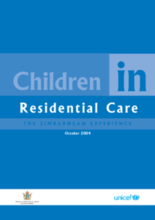Zimbabwe has been severely affected by the HIV and AIDS pandemic. One of the most tragic consequences of the disease has been an orphan crisis, marked by approximately 1,200,000 Zimbabwean children losing one or both parents to the disease. It is predicted that the number of orphans will continue to increase over the next ten years.
In response to this situation, the Government of Zimbabwe developed and adopted a National Orphan Care Policy, which sought to support traditional methods of care and discouraged forms of care which removed children from their communities and culture. This policy recommended foster care and adoption as the desired alternatives for children who did not have extended families and explicitly discouraged the use of institutional care. It clearly stated that placing a child in an orphanage should be regarded as a last resort, utilized only after all efforts to secure a better form of care have been exhausted.
This report provides an analysis of the current situation of children within institutional care in Zimbabwe. In particular it demonstrates how, despite government policy, the number of children living in institutional care continues to grow. At the time of the study, there were 3080 children in 56 institutional care facilities. In the last ten years the number of children living in institutional care has doubled; the number of institutional care facilities has increased by 75 percent. Furthermore, the report points out that development of new orphanages is often a result of the well intentioned but misguided efforts of donor groups: 80 percent were initiated by faith-based organizations. Following a detailed description of the major components of the child protection system in Zimbabwe, the study goes on to implicate some of the systemic weaknesses that have permitted orphanage proliferation. Ultimately, the analysis suggests that donors’ limited knowledge of national priorities combined with the government’s ineffective regulation of child protection services have led to inappropriate support for institutional care.
This report concludes with a series of strong recommendations on measures that the government might take to guide programming for children in need of care and protection, with a particular focus on strategies to coordinate donor efforts with national policies and goals that look to minimize the use of institutional care. It also suggests how existing institutions can be modified to improve the quality of care and better meet the psychological and developmental needs of children already in institutional care.
©Zimbabwe Ministry of Public Service, Labour and Social Welfare and UNICEF

